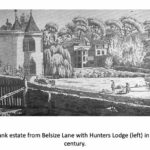In this article Averil Nottage provides a short taster of her local history walk on 12 May
Belsize means beautifully situated. Surrounded by open countryside and with fine views of London, Belsize was a perfect location for an aristocratic country estate.
Belsize House, situated near the junction of Belsize Park and Belsize Avenue, was probably built at the end of 15th century. In 1568 the house had 24 rooms, including a hall, long gallery, and a great chamber. Its 25 acres park was enclosed in a pentagonal wall surrounded by over 200 acres of farmland. The estate was leased to William Waad, an eminent statesman and diplomat whom Queen Elizabeth entrusted with her most delicate missions.
After the Restoration the house was rebuilt, and the estate passed to the Chesterfield family. By the early 18th century, they had moved out and the house was sublet. In 1720, with a flourish of trumpets, James Howell opened the house and grounds as a pleasure garden. It offered fine dining and wines, music, dancing in the lavish ballroom, fishing, hunting and betting. Initially it was very fashionable, and the Prince and Princess of Wales dined there, but soon after it was described as a “scandalous Lew’d House.” Magistrates intervened to prevent unlawful gaming and rioting.
It wasn’t until 1746, when the house was rebuilt as a private residence, that the area regained its respectability. After Ken Wood, it remained the pre-eminent park on the northern heights for another century.
In the sixteenth and seventeenth centuries several houses were built around Belsize Lane. In 1794 Baron Loughborough, the Lord Chancellor, bought one as his country residence. It was a substantial mansion in 21 acres and had a private drive. He held extravagant banquets there with guests including the Prince of Wales. The house was renamed Rosslyn House after he received an earldom in 1801.
 Queen Victoria visited it to see whether it would be a suitable place for her children to spend their summers. In 1808, when the 5th Earl of Chesterfield needed to clear his debts, the Belsize Estate was sold off as 8 sub estates. These miniature country estates, with “capital mansion houses” set in a few acres of park and surrounded by meadows, would be within the reach of successful businessmen.
Queen Victoria visited it to see whether it would be a suitable place for her children to spend their summers. In 1808, when the 5th Earl of Chesterfield needed to clear his debts, the Belsize Estate was sold off as 8 sub estates. These miniature country estates, with “capital mansion houses” set in a few acres of park and surrounded by meadows, would be within the reach of successful businessmen.
The lease for the most northern plot went to George Todd, a Baltic merchant who had made his fortune in Riga. He demolished a house in 16 acres of land to build a magnificent mansion called Belsize Court. Opposite the mansion, William Tate build a large cottage orne with gothic towers on the site of a “Chinese” cottage. Now known as Hunters Lodge, it remains on the corner of Belsize Lane and Wedderburn Road. Todd also built a grand house between Belsize Lane and Belsize Avenue called Ivy Bank.
Edward Bliss, who made his fortune by manufacturing gun flints in the Napoleonic War, bought the sub-estate between England’s Lane and Belsize Grove. He leased individual plots to builders, creating a piecemeal development.
 Nearly 38 houses were built by 1830 and occupied by “persons of quality”. Three “post Waterloo” houses at 129-133 Haverstock Hill, and a row of 1820s stuccoed houses on the south side of Belsize Grove, remain. John Maples, who owned the furniture store, lived for many years in Bedford House, a substantial property on the corner of Belsize Grove. It was advertised in the Times in 1905 as comprising of 13 bedrooms with dressing rooms, three bathrooms, dining, drawing, morning and billiard rooms, a library, conservatory, stabling for five horses and a garden with lawns, greenhouses etc.
Nearly 38 houses were built by 1830 and occupied by “persons of quality”. Three “post Waterloo” houses at 129-133 Haverstock Hill, and a row of 1820s stuccoed houses on the south side of Belsize Grove, remain. John Maples, who owned the furniture store, lived for many years in Bedford House, a substantial property on the corner of Belsize Grove. It was advertised in the Times in 1905 as comprising of 13 bedrooms with dressing rooms, three bathrooms, dining, drawing, morning and billiard rooms, a library, conservatory, stabling for five horses and a garden with lawns, greenhouses etc.
By the middle of the 19th century London was extending northward, creating demand for suburban housing. Belsize House was demolished in 1853 and replaced with the large stucco villas that characterise Belsize Park. In the 1860s land from the Rosslyn Estate and Belsize Court was taken to build Lyndhurst Gardens. Gradually other grounds and mansions made way for housing. Rosslyn House was sold to developers in 1896. In the 1920s the site of Ivy Bank became a motor car garage. Belsize Court was demolished in 1937 and replaced by blocks of flats of the same name. The houses on Bliss’s estate were mainly replaced by flats in the 1960s and 70s to meet the needs of the time. Bedford House wasn’t demolished until the 1980s. But whilst the mansions and estates have gone, we can still see their traces all around us when we know what was there before.
